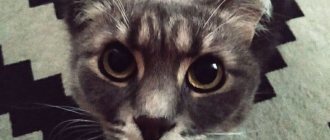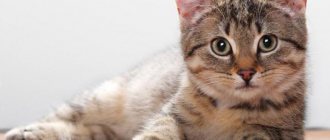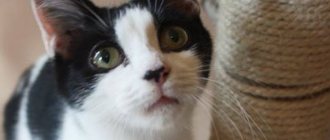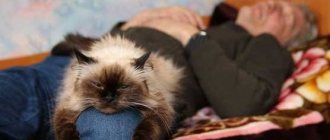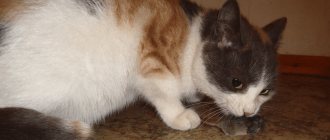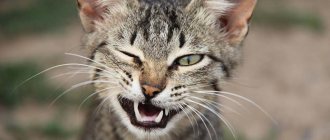- Posted by Ekaterina Gonina
- Date: January 20, 2019
Even in ancient times, people avoided direct eye contact with a cat, believing that this could cause misfortune. Scientists later confirmed that eye contact with a predator is indeed dangerous, but for a different reason. However, a lot depends on the circumstances and character of the animal, so in most cases there is no reason to be afraid of pets.
- 2 Is it scientifically possible to look a cat in the eye?
- 3 What to do if you accidentally make eye contact
- 4 Personal experience of animal owners
Features of cat behavior
Since ancient times, cats have lived alongside humans as pets. They were either revered as a deity, or exterminated as accomplices of the devil. The point is in their behavior, which is often incomprehensible to humans.
When it comes to keeping and caring for a cat, it is perhaps the most unpretentious animal. She does not need to be walked, unlike a dog, she does not litter like a rodent or a feathered pet. But it is almost impossible to train a cat.
If you try, she can do a couple of tricks, but she will perceive training as an exciting game, and not as obedience. There are legends about the waywardness of cats. Therefore, the cat perceives direct gaze as an invasion of its personal space and may react in different ways.
A little history
The cat was domesticated by humans about 10,000 years ago. At this time, the transition from nomadic to sedentary life began. A small animal was ideal for living in one place. It was of great benefit in exterminating small rodents in the house. The skeleton of an ancient cat was found in a Cypriot burial dating back to 7500 BC.
This is evidence of the domestication of the animal at this time and in this place. Around this time, the cat entered the service of humans, helped preserve the harvest, and fought with birds and rodents. At the same time, its small size did not require a large amount of food. Often there was enough food obtained by hunting in the house, in barns, in the barnyard.
There are different points of view regarding the domestication of cats. Some believe that man persistently and consistently tamed her ancestors to live together. He derived practical benefit from this. The cat helped preserve the harvest and at the same time was an easy and undemanding companion, affectionate and pleasant to talk to.
Other researchers believe that the process of bringing cats closer to humans was due to its intelligence. The animal understood that a human home would protect it from the wild and provide comfort to its offspring. And at the same time, it is convenient for hunting small rodents.
Cat's "look language"
Carefully observing a cat, you can notice that, like a person’s, its gaze is very expressive and conveys a lot of emotions:
- Hunting;
- Excitation;
- Relaxation;
- Dominance;
- Aggression;
- Confidence.
To better understand a cat’s behavior, you need to observe not only its gaze, but also its overall posture and behavior.
"Hunting". Many owners have observed how a cat's eyes widen funny when you attract it with a toy. The animal presses to the floor and moves its tail. This is a signal of attack and hunting. At this time, the cat is not afraid - she is hunting.
- Excitement – many cat owners have noticed how the cat’s pupils sharply constrict at the sound or rustling of a bag of food. This is a sign of strong emotions: fear, anger.
- Dominance - if a cat sits or lies close to the owner and watches his movements, almost without blinking, she is “in control.” Under natural conditions, this behavior can go either into a state of relaxation or into an attack. At home, a cat's behavior depends on its degree of trust in its owner.
- Aggression – Aggressive behavior is almost unusual for domestic cats. But if she presses her ears to her head, beats her tail and narrows her eyes, it means she will attack.
- Trust – often, the cat lies relaxed, but at the same time its eyes are wide open, the pupil is dilated, and the animal blinks slowly. If a cat does not cover its eyes when communicating with its owner, this is the highest degree of trust. In the wild, animals often squint to protect their eyes.
- An indicator of the closest understanding between the owner and the cat is the look called the “cat kiss.” When the cat is relaxed and lying down with slightly squinted eyes, look into her eyes and blink slowly. If the cat behaves the same way, this is a sign of complete mutual understanding.
If the cat itself tries to look into the eyes of its owner, it means it is hungry or requires attention.
Is it scientifically possible to look a cat in the eye?
It is much easier to explain the taboos and fear of cats from a scientific point of view. With direct eye contact, the animal feels threatened and becomes aggressive. This is due to the special structure of the organs of vision, which is strikingly different from the human one.
The lack of mutual understanding between people and cats may also be due to the fact that round pupils in the latter indicate the presence of unfavorable factors, while for people round pupils are the norm
A cat does not need to concentrate on one thing to control its surroundings. She has peripheral vision, thanks to which the animal easily notices what is happening around, even if for a long time it looks as if into emptiness. This is easy for cat owners to check: try, at a moment when the pet is relaxed, stand at the edge of his field of vision and take out his favorite toy or bag of food. This must be done silently and without unnecessary movements. Both of my cats react to this instantly, even if they are busy playing with each other or almost falling asleep.
Because of the placement of their eyes, cats are even better at perceiving what's happening to the side of them than what's directly in front of them.
Cats' pupils change shape depending on the distance at which the object that attracts their attention is located. Narrowing occurs when the object is close. The size of the pupils also affects light perception. The surface of a cat's eyes is covered with a layer of special cells called the tapetum. Its properties resemble a mirror and reflect light, which allows animals to see better in the dark. The darker the room, the more the pets' pupils dilate to catch more rays.
In reality, in terms of reflecting rays, we are not so different from pets: just remember the red-eye effect in a photo that appears due to the flash; human eyes just need more light
Although it seems to us that a cat's eyes glow in the dark, this is just a reflection and play of light. This is easy to check: try bringing your pet, for example, into the bathroom. In a completely dark room there is no light, there is nothing to be reflected, so the cat’s eyes will not glow. Another indirect evidence is a different shade when reflected. It depends on the pigment contained in the tapetum. The most common color is green or yellow, but other variations are possible. For example, my sister has 2 Siamese cats. Representatives of this breed have eyes that glow crimson in the dark.
Normally, a relaxed cat's pupils have the shape of a narrow ellipse, and the eyes are half-closed.
Most often, cats focus their gaze on a specific object during a hunt or conflict with another pet. Sometimes such behavior is associated with other intentions. For example, curiosity, fear, sexual desire, etc. Cats can communicate their love for their owner with their eyes, but this happens even less often and, as a rule, the animal does not look directly into the eyes at such moments. It is for this reason that direct eye contact is discouraged among predators. It is associated with aggression and anxiety, and can also signify the onset of rivalry. Prolonged contact will provoke the cat to attack.
If a cat wants to avoid an attack, it will arch its back: this helps it appear larger and stronger.
Pupil dilation and staring indicate that the cat is stressed. Her behavior is focused on full mobilization of forces. Dilated pupils allow you to capture more light and gain an advantage in a potential collision, and a close gaze is necessary to observe the actions of the object. Sometimes cats fight with just their eyes. For example, during the period of acquaintance, my favorites often sat in front of each other and looked attentively. In this way they sorted out the relationship: they tried to determine the hierarchical status of each. If it came to hissing and light chattering, then only after a few minutes. The one who looked away gave up and lost in advance. It was obvious from the appearance of the favorites that they were tense. The cats froze in one position, they could bend down to the floor, the tip of the tail darted from side to side. Before attacking, they pulled their ears back and bared their teeth.
Why is the game of staring contest dangerous?
Many have seen cat fights. Opponents arch their backs, growl or howl at each other, and make intense eye contact.
- For cats, a direct gaze is a sign that the enemy is about to attack.
- Since any person is many times larger than a cat, the animal is simply afraid of direct gaze.
Out of fear, a cat can attack, aiming for the face as the most unprotected part of the body. This is why you shouldn't look a cat in the eye.
The Scientific Approach: The Short Answer
Biologists have analyzed behavioral factors in detail. Before an animal fight, there is prolonged eye contact. Animals measure their strength in this way and frighten the enemy.
If the owner or guest stares at the pupils of the pet, then the latter intuitively accepts the challenge. Begins to get nervous and fear a more powerful opponent. Hence the changes tend to go in a bad direction. The male will “defend” the territory - mark, hide food in things, tear off curtains, scratch the wallpaper.
The animal perceives looking into the pupils as an attack, aggression. The female will become uncontrollable and panic. Regular stress will affect your health.
Reaction and character
Experts believe that it is almost impossible to predict what will happen if you look into a cat’s eyes. This largely depends on the nature of the pet and the conditions under which it is kept.
If a cat trusts people, is not offended, and feels safe, then the pet can withstand the direct gaze of even a stranger.
- More often than not, animals, and not just cats, are the first to look away.
- If a cat looks intently into the eyes of a random guest, you should not trust such a person.
- These animals sense non-verbal signs of insincere behavior very well and try to drive the “enemy” out of their territory.
Experts say that a cat regards direct gaze as a threat.
When communicating with your favorite furry, stick to the unspoken rule - look at him casually, trying not to make eye contact for a long time. There is no need to unnecessarily awaken animal tendencies in a little tiger cub and agitate its predatory hypostasis.
By the way, for yard cats your direct gaze means nothing and does not cause aggression on their part. Why this happens is difficult to answer. Apparently, they simply have nothing to share with you, or they are hoping to get a treat from you, and are ready to calmly look eye to eye.
Source
Signs and beliefs about cats
Many signs have developed as a way to convey safety rules in accessible language without explanation. The notorious sign about “a black cat crossing the road” was born during the Tatar-Mongol yoke.
If a cat crossed the road not far from the village, it means that the animal was left without a home and the village was ruined. Well, they “painted” it black to make it even more intimidating.
Protecting children from injuries that a cat can cause, older family members answer the question “Is it possible to look cats in the eyes?” They responded with a categorical ban, intimidating that “the cat will steal your soul.”
- The sign that if a cat looks into its eyes for a long time, the person will soon die also has a completely scientific explanation.
- Cats and dogs notice signs of illness faster than people, and since the cat's owner is a source of food, it thus expresses its concern.
- Observant people soon noticed that the cat was looking intently into the eyes - the man was dying. And they made the wrong conclusions, confusing cause and effect.
Even with a rational and strictly scientific approach, some features of cat behavior are quite difficult to explain.
Why do you dream of a cat's eyes?
Dream interpreters say: if a pair of cat eyes looks at you in a dream, this is not good. Most often, this is a warning of danger or injury, so it is best to exercise extreme caution throughout the day, especially in hazardous workplaces. When leaving home, if possible, avoid dark, unfamiliar, and little-frequented streets. If you are planning a trip to the doctor on this day, it is best to postpone it.
There is an opinion that cats, especially black ones, bring bad luck. In fact, this is not true. A loving animal will never cause you the slightest harm, both on the physical level and on the subtle plane. The same applies to stray cats, which you have absolutely no interest in (unless, of course, you feed them). Moreover, if a cat, calmly crossing your path, glances at you, consider this a good sign! This means that there is no danger for you, you can continue on your way completely calmly.
There is no need to offend cats because of prejudice. These are very smart and completely harmless animals if you know how to handle them correctly. If you don't get along with them, try to either find a common language with them or not communicate with them unnecessarily.
Mysticism and cats
Esotericists are sure that cats feel a person on an energetic level. You can believe it or not, but how can you explain that lost cats travel many kilometers and return home?
- Scientists still cannot explain why a purring cat significantly alleviates the condition of a sick person.
- Cats have a beneficial effect on the cardiovascular system of their owners. Their owners are much less likely to suffer from heart attacks and strokes.
- If a pet tries to lie down in a certain place and stares intently into the eyes, the owner has a reason to visit a doctor.
The cat feels the negative energy of the sore spot and tries to compensate for it.
Love your cat, win her trust and then you will understand each other at a glance.
Other signs about cats
The incredible abilities of kitties have been known for a long time. It is overgrown with many beliefs and myths. Here are the most verified:
- It is forbidden to hit the animal with your hand. Causing harm is punishable. Dark patrons will take revenge on the violator. Therefore, the prankster is beaten with a towel, slippers or other household items.
- If you scold the cat in the kitchen, the husband will leave the owner. If you want to teach a lesson, take him out into the corridor.
- You can't kiss a cutie on the face. Touching your lips to your nose is a release of pure energy. The kisser will definitely get sick.
- There is a strict taboo on expelling the murka from the house. If you take it, bear responsibility to the end. Take care, feed, treat. Otherwise you will bring trouble upon yourself. If you want to get rid of the animal, take it to a cat shelter; leave it in good hands.
- The kitty is the first to be let into a new house or apartment. It attracts prosperity.
- Where your pet often sleeps, you need to place a bed. The place is suitable for relaxation.
- Tricolor - brings happiness.
- Blue-eyed - protects against deception, fraud and self-interest.
- Licking his tail and hiding his head means trouble.
- Sneezes - toothache; next to your lover - for the wedding.
- He washes himself, sits on the windowsill or at the threshold - to visit the guests.
- Licking against the grain means rain; scrapes the floor - to bad weather, blizzards, increased wind.
- Doesn't leave the patient's bed - leads to death.
- Often lies on the table - does not like someone in the household.
- A black cat on a ship means a successful voyage.
- Scratching behind the ear - a visit from a guest.
- Calling for the exit - for a long trip.
The French believe that of all living earthlings, only cats remember the way to heaven. For this they are given supernatural and healing abilities.
Photos of the best cat breeds
Egyptian legends
According to ancient Egyptian legends, all cats are descendants of the goddess Bastet , who was revered as the mother of life. Being the daughter of Osiris and Isis, she also personified the light of the moon and the sun. They asked her for the blessings of life and health. Offending a cat was the same as cursing oneself, so they treated it with deep respect, and bowed their heads when they met.
The Egyptians believed that these animals could speak to the souls of the dead, so they brought them offerings of meat and asked them to convey the message to their deceased relatives. However, at the same time, they carefully avoided their gaze, since they believed that it was he who broke the line between the world of the living and the dead.
